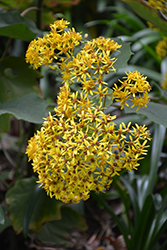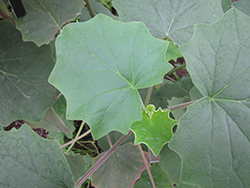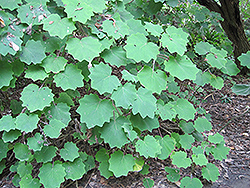Fri & Sat 8am - 8pm
Sun 8am - 7pm
Anytown, USA 12345
fax: 261.787.0463
e-mail: info@successgc.com


Plant Finder

Height: 10 feet
Spread: 10 feet
Sunlight:
![]()
![]()
Hardiness Zone: 9a
Other Names: form. Senecio petasitis, California Geranium
Group/Class: Groundsel Group
Description:
A large, sprawling evergreen shrub with large, roundish, velvety bright green leaves; deep burgundy flower buds open to display masses of bright yellow daisy flowers in winter and spring; prefers sheltered areas, leaves may be torn by wind
Ornamental Features
Velvet Groundsel features showy clusters of yellow daisy flowers with gold eyes held atop the branches from mid winter to mid spring, which emerge from distinctive burgundy flower buds. The flowers are excellent for cutting. It has attractive grayish green foliage with hints of silvery blue which emerges light green in spring. The large round leaves are highly ornamental and remain grayish green throughout the winter.
Landscape Attributes
Velvet Groundsel is a multi-stemmed evergreen shrub with an upright spreading habit of growth. Its strikingly bold and coarse texture can be very effective in a balanced landscape composition.
This shrub will require occasional maintenance and upkeep, and should only be pruned after flowering to avoid removing any of the current season's flowers. Deer don't particularly care for this plant and will usually leave it alone in favor of tastier treats. It has no significant negative characteristics.
Velvet Groundsel is recommended for the following landscape applications;
- Mass Planting
- Hedges/Screening
- General Garden Use
- Naturalizing And Woodland Gardens
- Container Planting
Planting & Growing
Velvet Groundsel will grow to be about 10 feet tall at maturity, with a spread of 10 feet. It has a low canopy with a typical clearance of 1 foot from the ground, and is suitable for planting under power lines. It grows at a medium rate, and under ideal conditions can be expected to live for approximately 10 years.
This shrub does best in full sun to partial shade. You may want to keep it away from hot, dry locations that receive direct afternoon sun or which get reflected sunlight, such as against the south side of a white wall. It does best in average to evenly moist conditions, but will not tolerate standing water. It is not particular as to soil type or pH, and is able to handle environmental salt. It is somewhat tolerant of urban pollution, and will benefit from being planted in a relatively sheltered location. This species is not originally from North America, and parts of it are known to be toxic to humans and animals, so care should be exercised in planting it around children and pets..
Velvet Groundsel makes a fine choice for the outdoor landscape, but it is also well-suited for use in outdoor pots and containers. Its large size and upright habit of growth lend it for use as a solitary accent, or in a composition surrounded by smaller plants around the base and those that spill over the edges. It is even sizeable enough that it can be grown alone in a suitable container. Note that when grown in a container, it may not perform exactly as indicated on the tag - this is to be expected. Also note that when growing plants in outdoor containers and baskets, they may require more frequent waterings than they would in the yard or garden.


